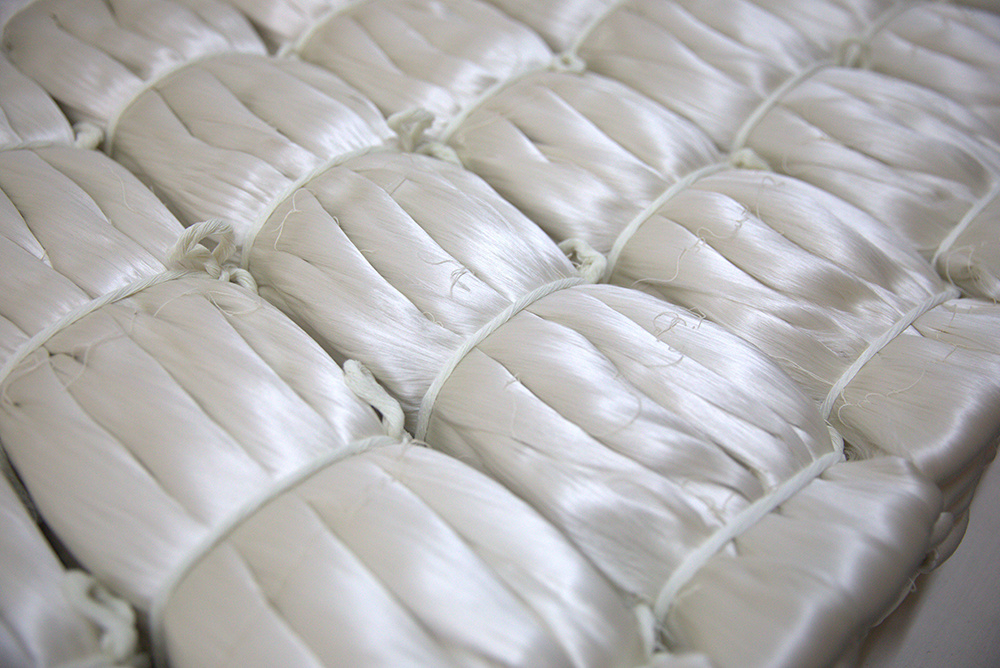Silk
Cocoon mixing: the cocoons with similar quality produced in different regions are mixed strictly according to the proportion required by the process, so as to expand the cocoon batch, stabilize the production, balance the cocoon quality, unify the silk color, and reink to produce raw silk with consistent quality.
Key words:
Dehong Zhengxin
Mulberry planting
Green Silk
The Silk Road
Classification:
Product Description
The production process of silk is a complex and delicate process, which mainly includes the following steps:
Preparation of 1. cocoons
Cocoon mixing: the cocoons with similar quality produced in different regions are mixed strictly according to the proportion required by the process, so as to expand the cocoon batch, stabilize the production, balance the cocoon quality, unify the silk color, and reink to produce raw silk with consistent quality.
Cocoon stripping: stripping off the cocoon clothing, that is, a layer of loose silk strands around the cocoon. Cocoon fiber fine and fragile, sericin content, can not be reeling, only as silk spinning raw materials. The amount of cocoon clothing stripped must be appropriate, too much stripping will affect the amount of silk, too little will affect the quality.
Selection of cocoons: remove the lower cocoons that cannot be reeled or the secondary cocoons that are difficult to reeled, such as double-palace cocoons, head-wearing cocoons, macular cocoons, firewood-printed cocoons, rotten cocoons, thin-skinned cocoons, etc. At the same time, large cocoons and small cocoons are sorted out according to the requirements of the silk reeling process.
2. cocoon cooking and silk reeling
Cocoon cooking: the use of water and heat, sometimes also add chemical additives, the silk sericin on the periphery of the cocoon appropriate swelling, soak soft, so that the glue force between the cocoon silk is less than the wetting strength of the cocoon silk, so that the cocoon silk can be continuously dissociated in turn during silk reeling. The quality of cocoon cooking directly affects the indicators related to the quality of raw silk, such as reeling, relaxation, deviation, cleaning, cleanliness, raw silk holding, etc., and also affects the average titer of raw silk.
Silk reeling: 8-10 pieces of cocoons with silk heads found are placed in the slot of the automatic silk reeling machine, and several pieces of silk are combined through porcelain eyes. With the help of the traction of the silk reeling machine, the cocoons are pulled out one after another and wound onto small ones, thus making real silk. Silk reeling is an important part of making real silk.
Finishing and Inspection of 3. Raw Silk
Re-shaking: Optimize the water content and cleanliness of raw silk.
Silk weaving: Bundling the raw silk after shaking.
Packing: pack the raw silk bound by the braid into bundles and wait for subsequent processing or storage.
Inspection: quality inspection of raw silk, including moisture regain, weight, filament width or bobbin diameter, elasticity, strength, elongation and holding of raw silk.
4. subsequent processing (for silk products)
For raw silk to be processed into silk products, the following steps are also required:
Weaving: Raw silk is divided into warp and weft after processing, and interwoven with each other according to certain organizational rules to form silk fabric. Before weaving, it is necessary to prepare for impregnation, wire merging, wire spinning, warp adjustment and weft rolling.
Dyeing and finishing printing: including raw silk and fabric refining, dyeing, printing and finishing four processes. Refining is to remove sericin and impurities from raw silk. Dyeing is to dye the fabric with various colors. Printing is to print the dye on the fabric according to the designed color. Finishing is to solve the problems left over from the previous processes and increase the taking function of the fabric.
The above is the complete production process of silk from cocoon to silk products. It should be noted that different types of cocoons (such as mulberry cocoons, tussah cocoons) and different uses of silk products (such as raw weaving, cooked weaving) may vary in the production process.
Get free product quotes
Welcome to leave your information to get in touch with us!







